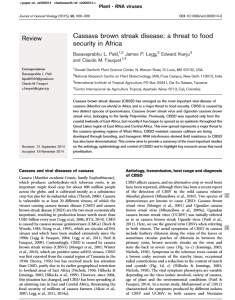Cassava brown streak disease (CBSD) has emerged as the most important viral disease of cassava (Manihot esculenta) in Africa and is a major threat to food security. CBSD is caused by two distinct species of ipomoviruses, Cassava brown streak virus and Ugandan cassava brown streak virus, belonging to the family Potyviridae. Previously, CBSD was reported only from the coastal lowlands of East Africa, but recently it has begun to spread as an epidemic throughout the Great Lakes region of East and Central Africa. This new spread represents a major threat to the cassava-growing regions of West Africa. CBSD-resistant cassava cultivars are being developed through breeding, and transgenic RNA interference-derived field resistance to CBSD has also been demonstrated. This review aims to provide a summary of the most important studies on the aetiology, epidemiology and control of CBSD and to highlight key research areas that need prioritisation.
Region: Not specific
Date published:
2014
Published by:
Journal of General Virology
Type of resource:
Journal article
Resource topic:
Cassava
Project/Programme: Not specific
Pest/Disease: Cassava brown streak disease
Pages:
13
File type:
External link (2.86MB)




